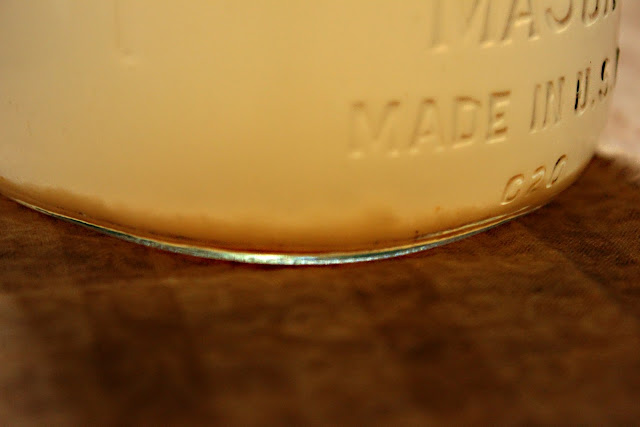Ta da! As promised, here is the latest tutorial here at the blog, and today we'll be going over how to make your own apple cider vinegar. But wait! Why one earth would you want ACV around your house anyway, and what's it good for? Oh I'm so glad to asked!
Apple cider vinegar is one of my "miracle cures" here on the farm. I use it for cleaning (in place of bleach), for boosting the immunity levels of the animals, for treating hoof rot (apply undiluted 2-3x's daily), it is rich in vitamins, minerals and trace elements, which are all quickly and easily absorbed into the system, and for use in the house and home, it makes unbelievable pie crusts (use instead of water). You can Google the benefits of raw apple cider vinegar and you'll find huge lists of pros. I love this stuff. It's awesome.
When I use it for the animals, which is the main reason I keep it around, I usually pour 1--2 cups of vinegar for every 5 gallons of water.
So, with all that being said, how do we go about making our own vinegar?
Step 1. Grab yourself a glass or ceramic bowl of any size (go by how big of a batch you would like to make). Don't use plastic or metal though... Neither one of those are vinegar friendly.
Step 2. Put a whole bunch of apple pieces in there. Whenever I'm making an apple pie, or we're dehydrating apples, all the peelings and cores are used for vinegar making instead of being thrown away or fed to the chickens. This is a perfect time to make yourself an apple pie, and then by the end of the day not only will you have a scrumptious snack cooling on the counter, but you'll have a batch of vinegar started as well! Whoohoo!
Don't fill your bowl *too* full of apple pieces. And yes, even the apple seeds can be thrown in. :)
Okay, Step 3! Fill your bowl with water so that your apples are covered by a good 1 inch. If your apple pieces are light like mine, then they'll probably float annoyingly. Just growl at it a few times and then leave it at that. You really can't teach apples to "sit and stay" unfortunately.
Step 4 is optional. You can put 1/4 cup of sugar in the bowl for every quart of water you have in there. This speeds up the fermentation process, but if you're in no hurry then you might as well save your sugar for the pie.
If you do want to put the sugar in though, just pour it in and then stir the apples around to distribute the sweet stuff evenly.
Step 5: Put a glass plate over your bowl and place the whole thing in a dark, cool area. I keep my small batches in our pantry; the bigger batches just have to get over it and be in the barn. Leave the bowl sitting quietly for a week!
Step 6: When the week is up, strain your fruity smelling liquid into a mason jar and feed the slightly fermented apples to the chickens, or throw it in the compost. What you'll have in your jar will be pale colored and have a slight vinegar smell to it.
Step 7. Find some loosely woven muslin and place it over your jar to act as a lid! Your vinegar needs to continue to "breathe" and the loose weave will allow the good bacteria that you want to get in there. It will also keep the vinegar smell at bay, believe it or not. I have 1 gallon of vinegar fermenting in the pantry, but you would never be able to tell by sticking your nose in there. Once you take the muslin off though, watch out!
Once you've done that, put the jar back in your dark, cool spot and let it sit another week. It's going to take 6 weeks from here on out before your ACV is ready, so be prepared!
Once a week, you will have to take the muslin off and give your vinegar a stir. On the very top of your liquid, you will see a bubbly, fermented disc. This is normal, and you want it! This bubbly thing is called the "mother" and it means that everything is going as it should be. As your vinegar ages, the disc may begin to take on a different look then what is in my picture below, and it may begin to become more solid. That too is normal, and just means that the mother is working.
You may also see a sediment on the bottom of your jars, which is a good thing. :)
Believe it or not, that's really all there is to it! Just stir the mother up once a week, and when six weeks have passed, you can replace the muslin for a real lid and then your apple cider vinegar is ready for use! It will also darken dramatically as it ages, and will look and smell just like the stuff from the store.
Apples + water = apple cider vinegar. It's cool stuff.




















6 comments:
I make my own, too! Usually I start it when I process the picked apples from canning.
Good for you! It is lovely stuff. Will your goats eat it? Mine turn their noses up.
Cool! I know what I'm working on this weekend. Apple cobbler and now vinegar.
Is this better to be inside now that it's cooler or could I put mine out in my laundry room, which is not insulated? Just wondered about the temp that's best. I tried this last Oct. and it was nasty. I like your directions better. And I have about 2 bushels of good organic apples from my trees right now. Thanks so much! I'm going to make some tomorrow after I get back from the market.
Once the 6 weeks is up and you replace the muslin with a lid, do you strain the liquid? Does the mother remain?
Jocelyn, my goats adore the ACV! If you put a flake of alfalfa and a bucket of straight ACV in front of them, they'll go for the vinegar first!
Kris, you want the storage temps to be between 65 and 85 degrees. Any warmer or colder, and then fermentation doesn't work as well/quickly. My 3-gallon batch that is in the barn seems to be doing okay though, and it's been dropping down to the low 40's at night. I would say inside, in your laundry room would be the best place for your vinegar while it's fermenting.
Seagrrlz, nope, you don't strain the liquid again after the 6 weeks are up. You just put a lid on and you're done! The mother does stay in there; you could however strain off a little bit of the mother to inoculate newer batches. I haven't done that though, so I can't give you any pointers on if that speeds the fermenting time or not.
I tried making it but it has been 5 weeks and the mother doesn't seem to be forming. What did I do wrong?
Post a Comment